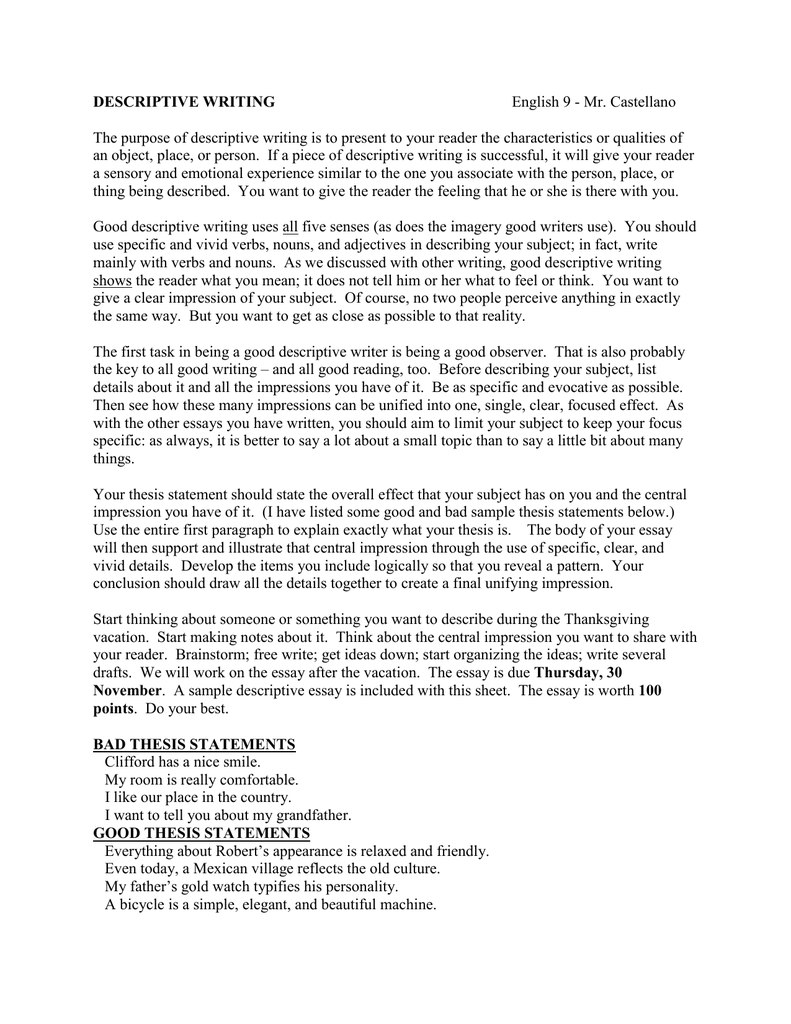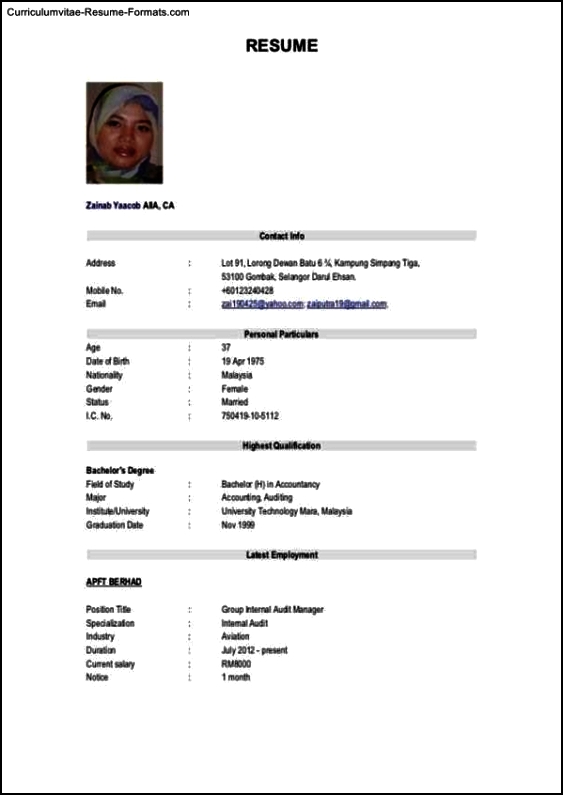
12/10/ · This is a descriptive writing piece that I wrote in response to a question for GCSE English Language – the question was ‘Write a description suggested by this photograph’ (photo below). It can be used for any student at any level – GCSE and above – to improve their creative writing skills, particularly on the following exam boards: AQA, CIE / Cambridge, Edexcel, OCR, WJEC / Eduqas, CCEA As you start with descriptive writing, identify exactly what you are setting out to describe. Usually, a descriptive piece will include the depiction of a person, a place, an experience, a situation, and the like. Anything that you experience or perceive about your subject can be the focal point of your descriptive writing The descriptive essay relies mostly on your five senses to bring a unique viewpoint to your readers. Typically, you can choose to write about an experience, person, place or thing when writing a descriptive essay. Open the essay with important details and descriptive writing that describe your subject and intrigue the reader
Descriptive Writing – GCSE English Language AQA Revision – Study Rocket
Descriptive writing is about using the power of words to arouse the imagination, capture the attention, and create a lasting impact in the mind of the reader. In this article, you'll learn how to employ descriptive elements in your writing, tips to enhance your descriptive writing skills, and some exercises to better yourself at it. Which one of the two do you find more interesting to read? Most definitely the second one. From this you can see that even something as simple as the above sentence can be transformed using literary devices that aid visualization, into something that someone can relate to.
This is what descriptive writing is all about: heightening the sense of perception and alluring your reader to read ahead, because you have so much more to say. Given below are a couple of good pieces of descriptive writing from authors who know their business. Its face was completely hidden beneath its hood.
She looked unexpectedly young. Her hair, which was completely white, had a yellowish cast that could almost have been mistaken for a pale blond, and it was loose around her shoulders.
And long. Longer than mine. No doubt she normally wore it pulled up in a bun, and such a style would have given her a more predictable little-old-lady look, but the way it was here now, parted on the side — long, loose, and straight — she seemed ageless as an ancient sculpture.
This sense was enhanced by her skin. Though it had the fragile crepeyness of age, she had few wrinkles, especially across her forehead, a piece of descriptive writing was smooth to a point of being almost waxy looking.
She was of obvious northern Germanic heritage, with pale eyes and prominent features, a piece of descriptive writing.
Although she was not overweight, her bones were big and blunt, giving the impression of a tall, sturdy woman. As you start with descriptive a piece of descriptive writing, identify exactly what you are setting out to describe. Usually, a piece of descriptive writing, a descriptive piece will include the depiction of a person, a place, an experience, a situation, and the like. Anything that you experience or perceive about your subject can be the focal point of your descriptive writing.
You build a backdrop by identifying an aspect of a subject that you want to describe. While it can be a wonderful creative exercise to simply describe anything you observe, in descriptive writing, there is often a specific reason to describe whatever you have set out to describe. Tapping this reason can help you keep the description focused and a piece of descriptive writing your language with the particular emotion or perspective that you want to convey to your readers.
This will render the effort of writing useless as the various descriptions will simply confuse the reader. For instance, if you want to describe characters in a particular situation, begin by describing the setting, a piece of descriptive writing, then proceed to the most important character of that particular situation, and then to the least important one if necessary.
Use Imagery Imagery is the best tool you can employ in descriptive writing. Since you cannot show your reader what you are imagining, you need to paint a picture with words. You need to make the depiction of your imagination so potent that your reader will instantly be able to visualize what you are describing. Make sure that the focus does not dwindle stray. Keep your descriptions specific to the subject in question. The writing must be able to draw in the reader; hence, the writer should say things that the reader can relate to or empathize with.
An introductory backdrop can often provide an effective setting for the remaining part of the piece. Great descriptive writing has the ability to lure the reader, enticing him or her to continue reading right to the end. While giving the details is important, it is how they are presented that makes the difference. Hone the senses One of the most effective ways to make the experience you are describing vivid for your reader is to use the five senses: smell, sight, sound, taste, and touch.
When the descriptions are focused on the senses, you provide specific and vivid details in such a way that it shows your reader what you are describing. It must make the reader imagine what he would see, hear, smell, taste, or feel when he reads what you have written. She gently squeezed the juice out of the plump, red tomato. She blended this juice into the simmering mix of golden-brown onions and garlic in the pan, and watched as they melded into each other, a piece of descriptive writing.
She then added the spice mixture that she had prepared, and the air was permeated with a mouth-watering aroma. Use strong nouns and verbs effectively, adjectives intelligently It is true that the purpose of adjectives is to describe a subject, but overuse of adjectives in descriptive writing can render the piece shallow and hollow. Hence, make it a point to use other parts of speech to express the same sentiment. For instance, look at the two sentences below, a piece of descriptive writing.
The first sentence has used an adjective fresh to describe the flowers. It is a good description too, because the comparison to morning dew is something that will immediately put the reader in the sense of mind that you want. The second sentence too has compared the freshness to morning dew, but has used a noun freshness and a verb equal to do so, and in the process has probably enticed the reader to continue reading, more than the first sentence.
Pick related words A piece of descriptive writing you actually begin writing, it is always a good idea to build a word bank of related words and ideas, a piece of descriptive writing. For instance, if you are going to be describing a flower arrangement, you could jot down a few ideas before you start describing it, like: vase, color, types of flowers, leaves, stem, style, shape, fresh, etc.
Once you have these a piece of descriptive writing words, you could start descriptive sentences for each one. Then, carry on from there. This will be close to impossible if your work does not reflect the passion that you feel for it.
Make them feel what you feel with the words you write. Language that relates to powerful emotions such as love, hatred, admiration, disgust, etc. Use them to your favor and get the desired effect. Given below are some simple, yet effective exercises that you can use to better yourself at descriptive writing. Exercise 2 Pick random objects like a hat, a burger, a chair, etc.
Enlist the different names that these objects can be called. Describe each of the objects in sentences that have more than 15 words each. Be as imaginative as you can. Make descriptive writing a rewarding experience, both for your reader and yourself.
If you like what you write, chances are that your reader will too. As is evident, having a comprehensive vocabulary is the key to good descriptive writing.
But mere vocabulary will fall short if your piece lacks passion, logic and interest. The trouble is that it can easily become an incoherent rambling of senses and emotions. To avoid that, present what you are writing about in a logical and organized sequence of thoughts, so that the reader comes away from it with a cogent sense of what you have attempted to describe.
Necessary cookies are absolutely essential for the website to function properly. This category only includes cookies that ensures basic functionalities and security features of the website. These cookies do not store any personal information. Any cookies that may not be particularly necessary for the website to function and is used specifically to collect user personal data via analytics, ads, other embedded contents are termed as non-necessary cookies. It is mandatory to procure user consent prior to running these cookies on your website.
Skip to primary navigation Skip to main content Skip to primary sidebar Skip to footer Descriptive Writing: Definition, Tips, Examples, and Exercises Descriptive writing is about using the power of words to arouse the imagination, capture the attention, and create a lasting impact in the mind of the reader. Share Tweet Pin LinkedIn Email. Next Post ». Get Updates Right to Your Inbox Sign up to receive the latest and greatest articles from our site automatically each week give or take right to your inbox.
If you are human, leave this field blank. May 10, This website uses cookies to improve your experience, a piece of descriptive writing. We'll assume you're ok with this, but you can opt-out if you wish.
Cookie settings Accept. Close Privacy Overview This website uses cookies to improve your experience while you navigate through the website. Out of these cookies, the cookies that are categorized as necessary are stored on your browser as they are essential for the working of basic functionalities of the website. We also use third-party cookies that help us analyze and understand how you use this website. These cookies will be stored in your browser only with your consent. You also have the option to opt-out of these cookies.
But opting out of some of these cookies may have an effect on your browsing experience. A piece of descriptive writing Necessary.
Non-necessary Non-necessary.
What is Descriptive writing?
, time: 2:43Descriptive writing - Descriptive - National 5 English Revision - BBC Bitesize

12/10/ · This is a descriptive writing piece that I wrote in response to a question for GCSE English Language – the question was ‘Write a description suggested by this photograph’ (photo below). It can be used for any student at any level – GCSE and above – to improve their creative writing skills, particularly on the following exam boards: AQA, CIE / Cambridge, Edexcel, OCR, WJEC / Eduqas, CCEA 3/22/ · Sunset Beach - Descriptive Piece. As I lay down onto the golden grains of sand, I looked up to the vibrant yet soothing streaks of colour that had filled the canvas of the sky. There were strokes of pink and orange that resembled the soft, supple skin of a perfectly ripened peach The descriptive essay relies mostly on your five senses to bring a unique viewpoint to your readers. Typically, you can choose to write about an experience, person, place or thing when writing a descriptive essay. Open the essay with important details and descriptive writing that describe your subject and intrigue the reader

No comments:
Post a Comment